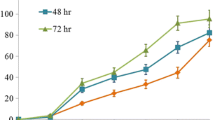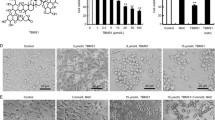Abstract
Background
Pharbitis nil (L.) Choisy (PN) is used as a traditional herb in East Asia and exhibits anti-parasitic, purgative, diuretic, anti-inflammatory, and anti-cancer activities. However, the molecular mechanisms underlying the anti-cancer activity are not well understood.
Objective
This study aims to elucidate the effects of reactive oxygen species (ROS), generated after treatment with the compound PN, on the induction of apoptosis and autophagy, which are pathways that underly the mechanisms of cell death and cell survival in human prostate cancer cells.
Results
The MTT assay and western blot analysis were used to assess the effects of compound PN on cell viability and the expression of apoptosis- and autophagy-related proteins in prostate cancer PC-3 cells. The effects of PN on apoptosis (via annexin V/propidium iodide staining), autophagy (via acridine orange staining), and ROS (via DCFH-DA staining) were investigated using flow cytometry. Compound PN induced the production of intracellular and mitochondrial ROS leading to increased apoptosis and autophagy in PC-3 cells. Interestingly, pretreatment with N-acetyl-l-cysteine (NAC), an intracellular ROS scavenger, enhanced compound PN-induced apoptosis, but reduced levels of autophagy. In contrast, pretreatment with diphenyleneiodonium (DPI), an inhibitor of mitochondrial ROS, reduced compound PN-induced apoptosis and enhanced autophagy. Inhibition of autophagy led to acceleration of apoptosis in a PN-induced ROS-dependent manner. Compound PN-induced ROS production from two different sources, an intracellular source and mitochondrial source. ROS production in these differing locations had different effects on apoptosis and autophagy. They acted either by promoting cell death or cell survival through regulating autophagy to either escape or enhance apoptotic cell death.
Conclusion
This crosstalk between ROS-activated signals in apoptosis and autophagy induction by PN provides new insights into the molecular mechanisms of this compound and suggests that PN may be a potential therapy for prostate cancer treatment.





Similar content being viewed by others
References
Chen YF et al (2017) The roles of reactive oxygen species (ROS) and autophagy in the survival and death of leukemia cells. Crit Rev Oncol Hematol 112:21–30
Choi HD et al (2017) Biological activities of Pharbitis nil and partial purification of anticancer agent from its extract. J Life Sci 27:225–232
Daido S et al (2005) Inhibition of the DNA-dependent protein kinase catalytic subunit radiosensitizes malignant glioma cells by inducing autophagy. Cancer Res 65:4368–4375. https://doi.org/10.1158/0008-5472.CAN-04-4202, https://www.ncbi.nlm.nih.gov/pubmed/15899829
Ju JH et al (2011) Induction of apoptotic cell death by Pharbitis nil extract in HER2-overexpressing MCF-7 cells. J Ethnopharmacol 133:126–131
Jung DY et al (2008) Triterpenoid saponins from the seeds of Pharbitis nil. Chem Pharm Bull (Tokyo) 56:203–206
Kim YA et al (2007) Mitochondria-mediated apoptosis by diallyl trisulfide in human prostate cancer cells is associated with generation of reactive oxygen species and regulated by Bax/Bak. Mol Cancer Ther 6:1599–1609
Kim KY et al (2013) Interplay of reactive oxygen species, intracellular Ca2+ and mitochondrial homeostasis in the apoptosis of prostate cancer cells by deoxypodophyllotoxin. J Cell Biochem 114:1124–1134
Kim KH et al (2014) Identification of antitumor lignans from the seeds of morning glory (Pharbitis nil). J Agric Food Chem 62:7746–7752
Kim SH et al (2016) Salinomycin simultaneously induces apoptosis and autophagy through generation of reactive oxygen species in osteosarcoma U2OS cells. Biochem Biophys Res Commun 473:607–613
Kim KY et al (2017a) Inhibition of autophagy promotes salinomycin-induced apoptosis via reactive oxygen species-mediated PI3K/AKT/mTOR and ERK/p38 MAPK-dependent signaling in human prostate cancer cells. Int J Mol Sci 18
Kim KY et al (2017b) Salinomycin induces reactive oxygen species and apoptosis in aggressive breast cancer cells as mediated with regulation of autophagy. Anticancer Res 37:1747–1758
Kim SH et al (2017c) Mitochondrial ROS activates ERK/autophagy pathway as a protected mechanism against deoxypodophyllotoxin-induced apoptosis. Oncotarget 8(67):111581–111596
Kim KH, Choi SU, Lee KR (2009) Diterpene glycosides from the seeds of Pharbitis nil. J Nat Prod 72:1121–1127
Ko SG et al (2004) Induction of apoptosis by Saussurea lappa and Pharbitis nil on AGS gastric cancer cells. Biol Pharm Bull 27:1604–1610
Lee WL, Huang JY, Shyur LF (2013) Phytoagents for cancer management: regulation of nucleic acid oxidation, ROS, and related mechanisms. Oxid Med Cell Longev 2013:925804
Levine B (2007) Cell biology: autophagy and cancer. Nature 446:745–747
Liou GY, Storz P (2010) Reactive oxygen species in cancer. Free Radic Res 44:479–496
Nicco C, Batteux F (2017) ROS Modulator Molecules with therapeutic potential in cancers treatments. Molecules 23(1):84
Panieri E, Santoro MM (2016) ROS homeostasis and metabolism: a dangerous liason in cancer cells. Cell Death Dis 7:e2253
Poillet-Perez L, Despouy G, Delage-Mourroux R, Boyer-Guittaut M (2015) Interplay between ROS and autophagy in cancer cells, from tumor initiation to cancer therapy. Redox Biol 4:184–192
Qanungo S, Wang M, Nieminen AL (2004) N-acetyl-l-cysteine enhances apoptosis through inhibition of nuclear factor-κB in hypoxic murine embryonic fibroblasts. J Biol Chem 279:50455–50464
Quillet-Mary A et al (1997) Implication of mitochondrial hydrogen peroxide generation in ceramide-induced apoptosis. J Biol Chem 272:21388–21395
Ray PD, Huang BW, Tsuji Y (2012) Reactive oxygen species (ROS) homeostasis and redox regulation in cellular signaling. Cell Signal 24:981–990
Song J et al (2009) Hypoxia-induced autophagy contributes to the chemoresistance of hepatocellular carcinoma cells. Autophagy 5:1131–1144
Srivastava KK, Kumar R (2015) Stress, oxidative injury and disease. Indian J Clin Biochem 30:3–10
Uttara B, Singh AV, Zamboni P, Mahajan RT (2009) Oxidative stress and neurodegenerative diseases: a review of upstream and downstream antioxidant therapeutic options. Curr Neuropharmacol 7:65–74
Yonekawa T, Thorburn A (2013) Autophagy and cell death. Essays Biochem 55:105–117
Acknowledgements
This work was supported by Basic Science Research Program through the National Research Foundation of Korea (NRF) funded by the Ministry of Education (NRF-2017R1D1A1B03032284) and by a grant (No. K18102) from the Korea Institute of Oriental Medicine funded by the Ministry of Education, Science and Technology (MEST), Republic of Korea.
Author information
Authors and Affiliations
Contributions
HD Choi, KY Kim, and KI Park conducted research and experiments, designed research, and wrote the paper. SH Kim, SG Park, SN Yu and YW Kim conducted research and experiments. DS Kim, KT Chung and SC Ahn reviewed the literature, revised the manuscript and coordinated the study. All authors read and approved the final manuscript.
Corresponding author
Ethics declarations
Conflict of interest
The authors declare that they have no competing interests.
Human and animal rights
The experimental procedure followed the actual law of animal protection that was approved by the Institutional Animal Care and Use Committee of Korea Institute of Oriental Medicine, Korea.
Additional information
Publisher's Note
Springer Nature remains neutral with regard to jurisdictional claims in published maps and institutional affiliations.
Rights and permissions
About this article
Cite this article
Choi, H.D., Kim, KY., Park, K.I. et al. Dual role of reactive oxygen species in autophagy and apoptosis induced by compound PN in prostate cancer cells. Mol. Cell. Toxicol. 17, 41–50 (2021). https://doi.org/10.1007/s13273-020-00107-4
Accepted:
Published:
Issue Date:
DOI: https://doi.org/10.1007/s13273-020-00107-4




